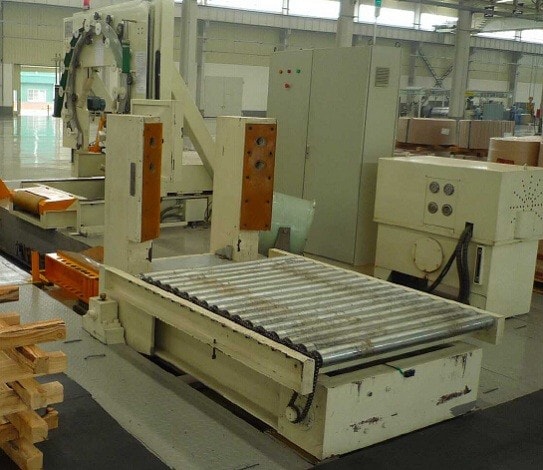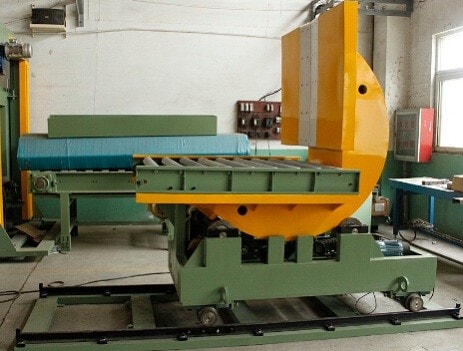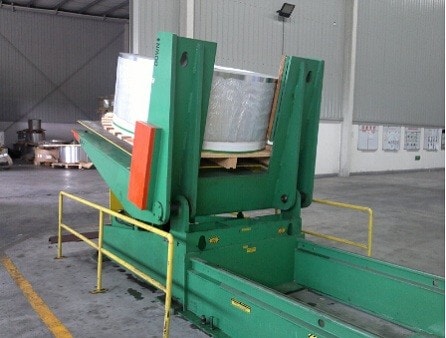Click to Chat
I'm online now.
Fhopepack Innovation
A hydraulic upender (also known as a hydraulic tilter or hydraulic coil upender) is a machine that uses hydraulic cylinders to lift and rotate heavy or awkward objects from a horizontal position to a vertical position. They are commonly used in the manufacturing and processing industries to facilitate the handling, storage, and transportation of materials such as steel coils, drums, and other larg



Both the mechanical coil and the hydraulic coil upenders are designed to perform the same function, and the weight and shape of the load will determine which type to use.
Customer:
1. Baosteel Group Corporation)
Shanghai Baoshan Iron & Steel Complex, No. 1900, Tongji Road, Baoshan District, Shanghai, China
2. 鞍钢股份有限公司 (Angang Steel Company Limited)
Anshan Iron & Steel Complex, Anshan City, Liaoning Province, China
Machine: 30T, coil OD: 800-1800mm , floor pit installation for floor level operation.
I. Introduction
II. Components and working principle of hydraulic upenders
III. Applications of hydraulic upenders
IV. Advantages of hydraulic upenders
V. Factors to consider when choosing a hydraulic upender
VI. Conclusion
VII. Frequently Asked Questions (FAQs)
Hydraulic upenders are an essential tool in material handling, offering improved safety, efficiency, and versatility for various applications. They are designed to lift, tilt, and rotate heavy loads, making them invaluable in industries that require frequent handling of heavy objects.

The hydraulic system is the driving force behind the upender, using hydraulic fluid to transmit power from the pump to the actuators. This fluid is compressed by the pump, creating pressure that moves the hydraulic cylinders, generating the force required to lift and tilt the load.
The upending platform, also known as the tilting platform or cradle, is the part of the hydraulic upender that holds the load. It is attached to the hydraulic cylinders and is responsible for securely supporting the load during lifting, tilting, and rotating processes.
The control system manages the operation of the hydraulic upender, allowing the operator to control the upending platform's movements accurately. It can include buttons, levers, or even digital controls, depending on the specific upender model.
In the steel, aluminum, and other metal industries, hydraulic upenders are used to handle heavy metal coils. They make it easier to transfer, load, and unload coils while reducing the risk of damage and ensuring worker safety.
Hydraulic upenders are invaluable in the manufacturing sector, particularly in die and mold handling. They help transport, position, and install heavy dies and molds with ease, allowing for more efficient and safer production processes.
Large equipment such as transformers, engines, and generators often require hydraulic upenders for safe and efficient handling. They enable proper positioning and installation, reducing the risk of accidents and increasing productivity.
Hydraulic upenders significantly reduce the risk of accidents and injuries by providing a safe and stable platform for handling heavy loads. They eliminate the need for manual lifting and positioning, reducing worker strain and fatigue.
By automating the lifting, tilting, and rotating processes, hydraulic upenders increase productivity and efficiency in various applications. They allow workers to focus on other tasks, optimizing workflow and reducing downtime.
Hydraulic upenders can be customized to handle a wide range of load capacities, sizes, and shapes, making them suitable for various industries and applications.
Before selecting a hydraulic upender, it's crucial to consider the maximum load it
will need to handle. Upenders are available with different load capacities, so choose one that meets or exceeds the weight of the heaviest item you plan to handle.
The size of the upending platform should be appropriate for the objects you intend to handle. Ensure the platform is large enough to accommodate your loads securely but not so large that it takes up unnecessary space in your facility.
Some hydraulic upenders can be customized to suit specific requirements, such as additional safety features, different control systems, or specialized platform designs. Consider your unique needs when selecting an upender to ensure it can accommodate your specific application.
Hydraulic upenders are a critical tool in material handling, providing enhanced safety, efficiency, and versatility across various applications. By understanding their components, working principles, and benefits, you can choose the right hydraulic upender for your needs, optimizing your workflow and minimizing the risk of accidents.
What are the main components of a hydraulic upender? The main components of a hydraulic upender include the hydraulic system, upending platform, and control system.
What industries commonly use hydraulic upenders? Hydraulic upenders are used in various industries, including steel and aluminum manufacturing, die and mold handling, and heavy equipment handling.
What are the benefits of using hydraulic upenders? Hydraulic upenders offer enhanced safety, improved efficiency, and versatility in material handling applications.
How do I choose the right hydraulic upender for my needs? Consider factors such as load capacity, platform size, and customization options when selecting a hydraulic upender that best suits your requirements.
Can hydraulic upenders be customized? Yes, some hydraulic upenders can be customized to meet specific requirements, such as additional safety features, different control systems, or specialized platform designs.
Related Pictures:
Upender/tilter + coil wrapping machine
Upender/tilter + track
Hydraulic upender/tilter for steel coil
Steel coil transfer car
Related Videos:
I'm online now.